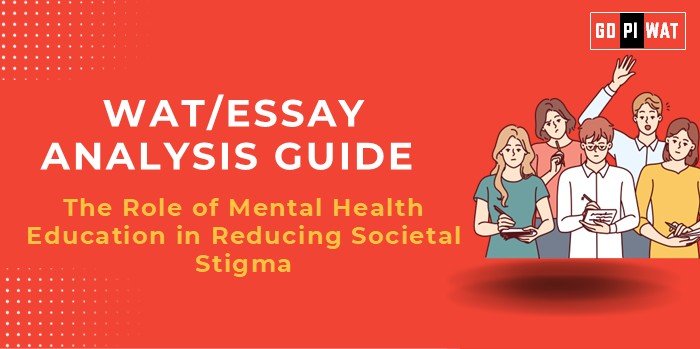📋 WAT/Essay Analysis Guide: The Role of Mental Health Education in Reducing Societal Stigma
🌐 Understanding the Topic’s Importance
Mental health education addresses critical social and economic challenges by normalizing conversations and equipping individuals with tools to combat stigma. For B-schools, the topic connects with leadership, policy innovation, and social responsibility.
📝 Effective Planning and Writing
- Time Allocation: Plan (5 minutes), Write (20 minutes), Review (5 minutes).
- Preparation Tips:
- Research key statistics.
- Include regional/global examples.
- Outline arguments clearly.
📖 Introduction Techniques for Essays
- Contrast Approach: “While mental health is a global crisis, education remains the least utilized tool to combat stigma.”
- Solution-Based Approach: “Integrating mental health education into curriculums can break the stigma’s vicious cycle.”
📊 Structuring the Essay Body
- Achievements: Highlight policy successes, awareness campaigns, and statistical improvements.
- Challenges: Address resource gaps, cultural barriers, and funding issues.
- Future Outlook: Propose solutions, including public-private partnerships and leveraging technology.
📄 Concluding Effectively
- Balanced Perspective: “Reducing stigma requires education, policy reforms, and accessible healthcare.”
- Global Context: “As countries like Canada show success, India can adapt similar frameworks for sustainable impact.”
✍️ Sample Short Essays
Balanced Perspective:
“Mental health education is essential to combat stigma, yet systemic challenges like funding and cultural barriers remain. Collaborative efforts can amplify its impact globally.”
Solution-Oriented:
“By incorporating mental health education into schools and workplaces, societies can foster empathy, reduce stigma, and enhance productivity.”
Global Comparison:
“While Canada’s campaigns show the potential of education, India’s tailored programs for diverse communities could drive inclusive change.”


